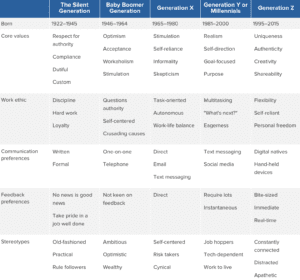A multigenerational workforce is an incredibly diverse group consisting of working professionals across generations. Today’s American workforce is regarded as one of the most distinctive multigenerational landscapes. It has five generations actively working: traditionalists, baby boomers, generation X, millennials and generation Z. The picture below from SMARP highlights the approximate age range for each of these generations.
Organizations across the world now operate with the help of workforces that represent four to five generations. This change has been facilitated by older employees opting to work longer and younger generations seeking industry experience early on. While a multigenerational workforce provides more perspectives and a range of solutions, it can also lead to workplace conflicts due to generational conflicts and gaps.

Advantages Of A Multigenerational Workforce
“More than 86 percent of global companies say a multigenerational workforce is valuable to their success and growth,” said Jo Ann Jenkins, CEO of The American Association of Retired Persons. The statistic highlights that companies have been using their diverse workforce as a competitive advantage instead of looking at the drawbacks. The following benefits can be used to help companies stand out.
- While cognitive abilities and fluid intelligence of employees decline as they age, the crystallized intelligence of older employees is extremely valuable to companies. Companies have been using crystallized intelligence power, which is based on wisdom, experience and the ability to recognise patterns. It can be greatly beneficial during strategic planning and problem-solving. This type of intelligence remains relatively stable and can even increase as employees age.
- A diverse team facilitates greater interaction between subordinates and managers. This mutually beneficial interaction allows all parties to learn from each other and advance their skills. In fact, the newer generation prefers companies that have a multigenerational workforce so they have greater exposure to mentoring opportunities. Mentors provide valuable feedback to younger employees and share advice based on their experiences. More importantly, younger employees can give back to their mentors by helping them stay up-to-date with technology.
How To Lead A Multigenerational Workforce
It is a challenge to seamlessly meet the needs and lead an age-diverse workplace. According to a survey, only 6% of organizations strongly agree that their leaders are equipped to lead a multigenerational workforce effectively and another study showed that ‘intergenerational cohesion’ is one of the top three workplace risks. However, with the right solutions, a company can efficiently maximise the benefits a varied workforce offers.
- Understand Their Needs
The first step to leading a multigenerational workforce is always understanding the needs of every generation. While it is important to understand overall common characteristics and features, it is essential to not stereotype. Managers should survey employees to find out their expectations and group based on those replies. These expectations could range from compensation packages to the workload itself. While older employees don’t expect monitoring and frequent detailed performance evaluation, younger employees seek as much feedback as possible. Grouping based on these expectations can be effective and can lead to greater satisfaction within all the generations in the organisation.
Stereotyping based on age can lead to missed opportunities and failure. “There’s no overall relationship between age and job performance,” said Michael S. North, Assistant Professor of Management and Organizations at NYU Stern. For example, Henry Ford was 45 when he created the famous Model T car. Invest in employees based on performance and ability, not a myth.

2. Offer Development Opportunities To All Employees
While it is commonly known that the younger generation always seeks professional development opportunities to grow and rise the ranks quickly, older workers try to learn and grow as much as possible as well. In fact, a study by Wainhouse Research and D2L concluded that younger and older workers have surprisingly similar preferences for workplace learning, with all generations continuously seeking self improvement and enhancement.
It isn’t easy to meet the needs and manage a diverse workplace but most problems can be solved by facilitating interaction between age groups, encouraging a culture of care with collaboration and improved communication. With all these factors in check, productivity, morale and motivation can increase.







